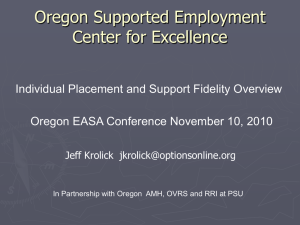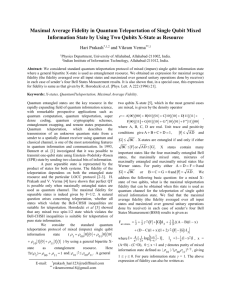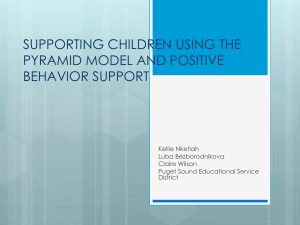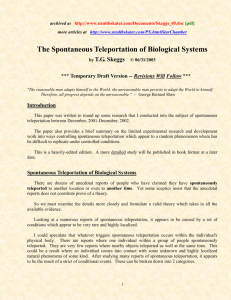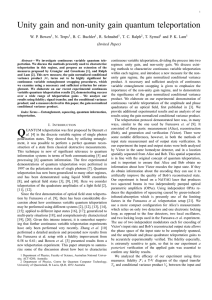Supplementary Notes
advertisement
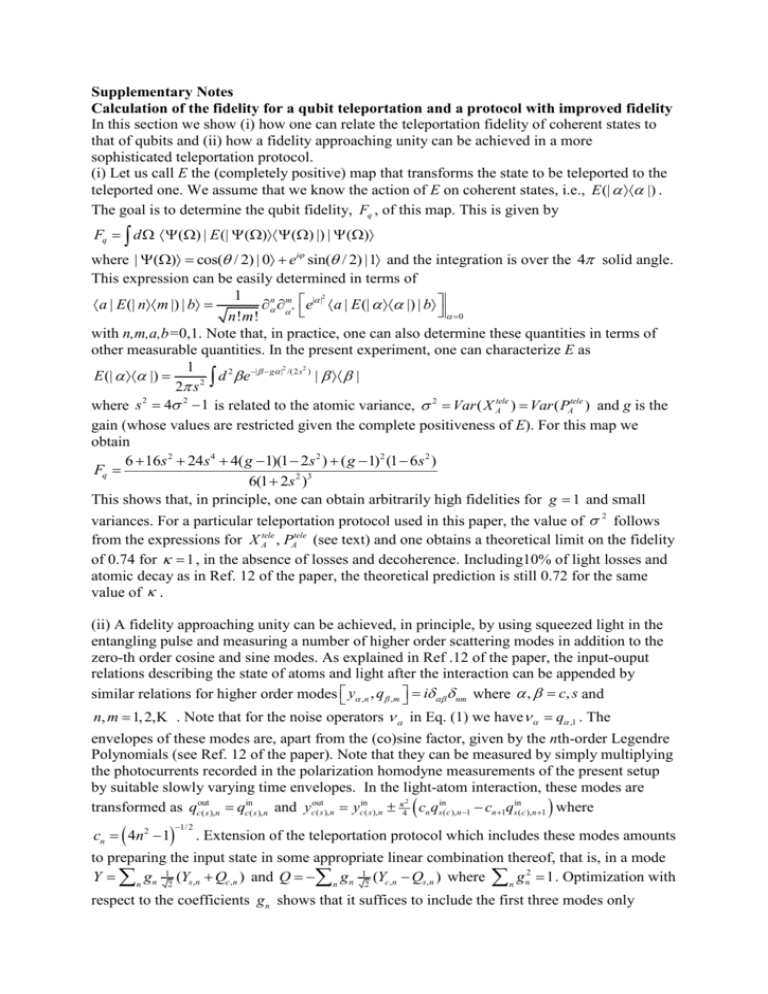
Supplementary Notes Calculation of the fidelity for a qubit teleportation and a protocol with improved fidelity In this section we show (i) how one can relate the teleportation fidelity of coherent states to that of qubits and (ii) how a fidelity approaching unity can be achieved in a more sophisticated teleportation protocol. (i) Let us call E the (completely positive) map that transforms the state to be teleported to the teleported one. We assume that we know the action of E on coherent states, i.e., E (| |) . The goal is to determine the qubit fidelity, Fq , of this map. This is given by Fq d () | E (| () () |) | () where | () cos( / 2) | 0 ei sin( / 2) |1 and the integration is over the 4 solid angle. This expression can be easily determined in terms of 2 1 a | E (| n m |) | b n m e| | a | E (| |) | b 0 n !m ! with n,m,a,b=0,1. Note that, in practice, one can also determine these quantities in terms of other measurable quantities. In the present experiment, one can characterize E as 2 2 1 E (| |) d 2 e | g | /(2 s ) | | 2 2 s 2 where s 4 2 1 is related to the atomic variance, 2 Var ( X Atele ) Var ( PAtele ) and g is the gain (whose values are restricted given the complete positiveness of E). For this map we obtain 6 16s 2 24s 4 4( g 1)(1 2s 2 ) ( g 1) 2 (1 6s 2 ) Fq 6(1 2s 2 )3 This shows that, in principle, one can obtain arbitrarily high fidelities for g 1 and small variances. For a particular teleportation protocol used in this paper, the value of 2 follows from the expressions for X Atele , PAtele (see text) and one obtains a theoretical limit on the fidelity of 0.74 for 1 , in the absence of losses and decoherence. Including10% of light losses and atomic decay as in Ref. 12 of the paper, the theoretical prediction is still 0.72 for the same value of . (ii) A fidelity approaching unity can be achieved, in principle, by using squeezed light in the entangling pulse and measuring a number of higher order scattering modes in addition to the zero-th order cosine and sine modes. As explained in Ref .12 of the paper, the input-ouput relations describing the state of atoms and light after the interaction can be appended by similar relations for higher order modes y ,n , q ,m i nm where , c, s and n, m 1, 2, K . Note that for the noise operators in Eq. (1) we have q ,1 . The envelopes of these modes are, apart from the (co)sine factor, given by the nth-order Legendre Polynomials (see Ref. 12 of the paper). Note that they can be measured by simply multiplying the photocurrents recorded in the polarization homodyne measurements of the present setup by suitable slowly varying time envelopes. In the light-atom interaction, these modes are out in in in in 2 transformed as qcout ( s ), n qc ( s ), n and yc ( s ), n yc ( s ), n 4 cn qs ( c ), n 1 cn 1qs ( c ), n 1 where cn 4n2 1 1/ 2 . Extension of the teleportation protocol which includes these modes amounts to preparing the input state in some appropriate linear combination thereof, that is, in a mode Y n gn 12 (Ys ,n Qc ,n ) and Q n gn 12 (Yc ,n Qs ,n ) where n g n2 1 . Optimization with respect to the coefficients g n shows that it suffices to include the first three modes only ( g n = 0 for n > 3 ) in order to achieve a final state of atoms after the feedback which is close to X Atele Y 1 2 n gn ysin,n and PAtele Q 1 2 n g n ycin,n . The sums in these expressions amount to half a unit of vacuum noise in each spin component or a teleportation fidelity of F 0.80 . The corresponding optimal coefficients g n determine the envelope of the input mode Y ,Q , which is a slowly decaying profile, as shown in Figure 1. The remaining half unit of added noise is due to the vacuum fluctuations of the entangling beam. It is possible to reduce this remaining noise by using squeezed light, such that the fidelity would approach unity, as the variances of yin,n approach zero. The squeezing spectrum should be broad enough to cover the sidebands at ± 322kHz , which is trivial with existing squeezing sources, for example squeezing of 6 dB was observed within the bandwidth of 2 MHz in Ref. 25 of the paper. Squeezing of 6dB (10dB) would yield the fidelity of F 0.93 ( F 0.96) . Details about these improved protocols will be presented elsewhere. Figure 1: Optimal pulse envelope A(t) for the input state versus time t in units of pulse length T for a coupling strength of 2.3 and light squeezing of 6dB in an improved teleportation protocol including the first three scattering modes. The corresponding fidelity is 0.93. (The square integral of A(t) is normalized to 1.)


